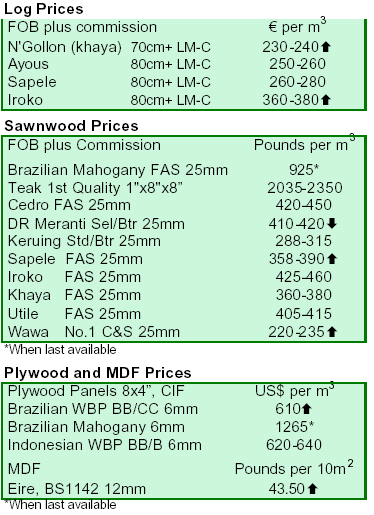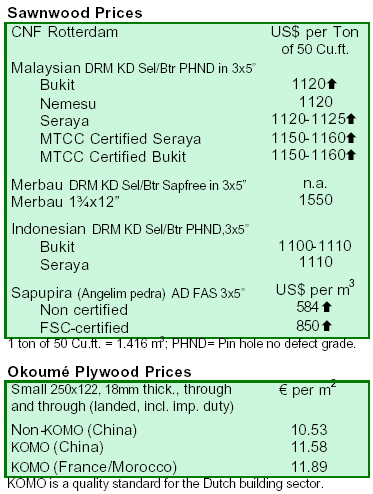|
Report
from the UK
Dollar
Exchange Rates of 6th January 2006
EU
0.823
Tropical imports halved in the last 15 years
The UK imports 90% of its timber requirements. About 80% of the import total is softwood and 10%
plywood and other panel products. There is no plywood manufacture in the UK. About 10% of the
imports are hardwood, of which tropical now only accounts for a reducing total of about 300,000 m3 ,
under half the amount imported 15 years ago.
Buyers unwilling to pay a premium
The largest consumer of timber products is the construction industry, which demand fluctuates with
house building activity. The main user of tropical species is joinery, where durability, appearance and
quality for high-class furniture are paramount. Imported hardwood is subject to uncertain transport
costs and exchange rates, which make selling on a forward basis risky for both buyer and seller,
particularly when competition is strong, and margins tight. The main factor, which has
contributed to reduction of tropical hardwood usage in the UK, is the conservation lobby, which
probably carries more weight than in most other markets, and therefore the need for a continuous
supply of sustainably-produced certified supplies. However, buyers are loath to pay any additional
premium for that reassurance because there are cheaper non-solid timber alternatives available such
as MDF or UPVC (unplasticised PVC), neither of which get the same level of bad publicity.
Hardwood sales profits down
At the end of 2005, James Latham plc, an old established hardwood importer, revealed a 7.3%
increase in sales but lower profits indicating the competitive nature of the market place. B&Q, the
DIY retailer, also reported a 50% drop in profits in the third quarter of 2005 and proceeded with the
closure of 22 outlets. UK¡¯s promotional vehicle ¡®wood for good¡¯ is at last
gaining support from the trade generally and hopes to expand in 2006.

Report
from the Netherlands
Supply from Brazil remains problematical
The supply situation from Brazil to the Dutch market remains complicated due mainly to lack of
approval of harvesting permits. Only mills strictly dealing with FSC-material seem to have clearance
from IBAMA after some persuasion from Dutch traders. After the long production standstill and
personnel lay-offs, mills will need some time before production is back to normal levels and shipments
resume. Meanwhile, delays in the execution of outstanding purchase orders seem unavoidable.
Meranti prices bullish despite dull demand
The Dutch timber market resumed activities on 9 January after Christmas leave. However, business
activities started slowly as the trade in hardwoods have been rather flat since late 2005. The trade in
dark red meranti (DRM) has been partic ularly dull for many weeks. The slow demand had prompted a
severe eroding of the sales prices, which for some items have fallen as low as .625 per m3 free
delivered, metric measurement, despite tight supply. The production of DRM sawnwood continues to be
severely hindered by the wet monsoon in Malaysia,the worst in the past 25 years according to some
analysts. The overall unsold forward position held by exporters is reported as low. Some items, such as
strips and shorts, are in acute shortage as less timber in larger cross-section is cut and produced by
sawmills. Furthermore, with short supply of round logs in large diameters, it is also very difficult to
obtain large Dutch widths such as DRM in 1.3/4 x12¡±. Accordingly, the CNF Rotterdam price for this
dimension has climbed recently. There are other examples. Prices for meranti 4x5¡±,the CNF Rotterdam-level, remained very firm while
those for 3x5¡± increased further. Part of the increase, however, was due to the rise in the
container freight-rate effective 1 January 2006. The new prices also reflect the precarious weather
situation in Peninsular Malaysia. Since most sawmills in Malaysia will cease operations on 29
January through February for Chinese New Year leave, supply of DRM will remain tight. Some mills
have closed already due to lack of logs for cutting.
Chinese New Year ¡°offers¡± do not take place
Just before the Chinese New Year celebrations,some exporters try to generate some business in the
Dutch market by offering attractively priced parcels.This year such ¡®special offers¡¯ were not taking
place.Exporters expect a reactivation of the Dutch market during spring as more building permits have been
issued in the Netherlands. Since building reactivation leads to higher timber consumption,
exporters are dosing offers to keep some in reserve for better times to come. Exporters thus seem less
alarmed at sales below cost made occasionally by some Dutch traders trying to generate some
business.
Demand for iroko at a standstill
Dutch traders are not placing fresh orders for iroko despite attractive prices. When the CNF Rotterdam
price for Iroko was rising, importers increased stock levels. Now, when prices are declining due to better
supply, the market seems to be somewhat saturated leading to a standstill in purchases. Some analysts
think that this situation will hold for a while. Sapele prices making meranti more competitive
Until recently, sapele sawnwood had an edge over DRM on pricing. Priced at CNF .550 per m3, sapele
was stealing market share away from meranti. However, and as anticipated by the MIS, sapele
prices are climbing and reaching .620 per m3 CNF,making meranti more competitive.
Malaysian plywood¡¯s duty reduced to 3.5%
The import duty for Malaysian plywood was reduced from 7% to 3.5%, with effect from 1
January 2006. Malaysia has obtained again the status of developing country. Under the Generalised
System of Preferences, Malaysian mouldings are now also exempted from import duty. Indonesian
plywood was not affected and import duty remains at 7%. Plywood from China, which is no longer
considered a developing country, is now levied at 7%, up from 2-3.1% in 2005.
Dutch plywood demand expected to rise
The demand for plywood fluctuated from September up to early December in Belgium and
the Netherlands, according to Euwid. However, some sources in the Netherlands expect a major
surge in building investment this year, as there would be a shortage in housing space in some
regions.
Demand for Indonesian and Malaysian plywood in the Benelux countries is usually slow in the last
quarter of the year. Nonetheless, some importers planned to raise plywood imports from Malaysia,
expecting that EU import duties on Malaysian plywood would be lowered from 7% to 3.5% from 1
January 2006. The lead time for Indonesian and Malaysian plywood is estimated at around two
months, compared to 4-6 weeks for Chinese plywood.

|